Cooking the perfect beef steak is an art that combines knowledge, skill, and a touch of passion. From selecting the right cut to mastering cooking techniques, every step plays a role in crafting a steakhouse-quality experience right in your kitchen. Whether you’re a grilling novice or an experienced home chef, this guide will help you unlock the secrets to juicy, tender perfection.
You’ll learn the essentials of choosing the best cut of beef, prepping like a professional, and seasoning for maximum flavor. Plus, we’ll explore foolproof cooking methods, presentation tips, and common mistakes to avoid. Ready to unleash your inner steakhouse chef? Let’s dive in!
The Importance of Choosing the Right Cut
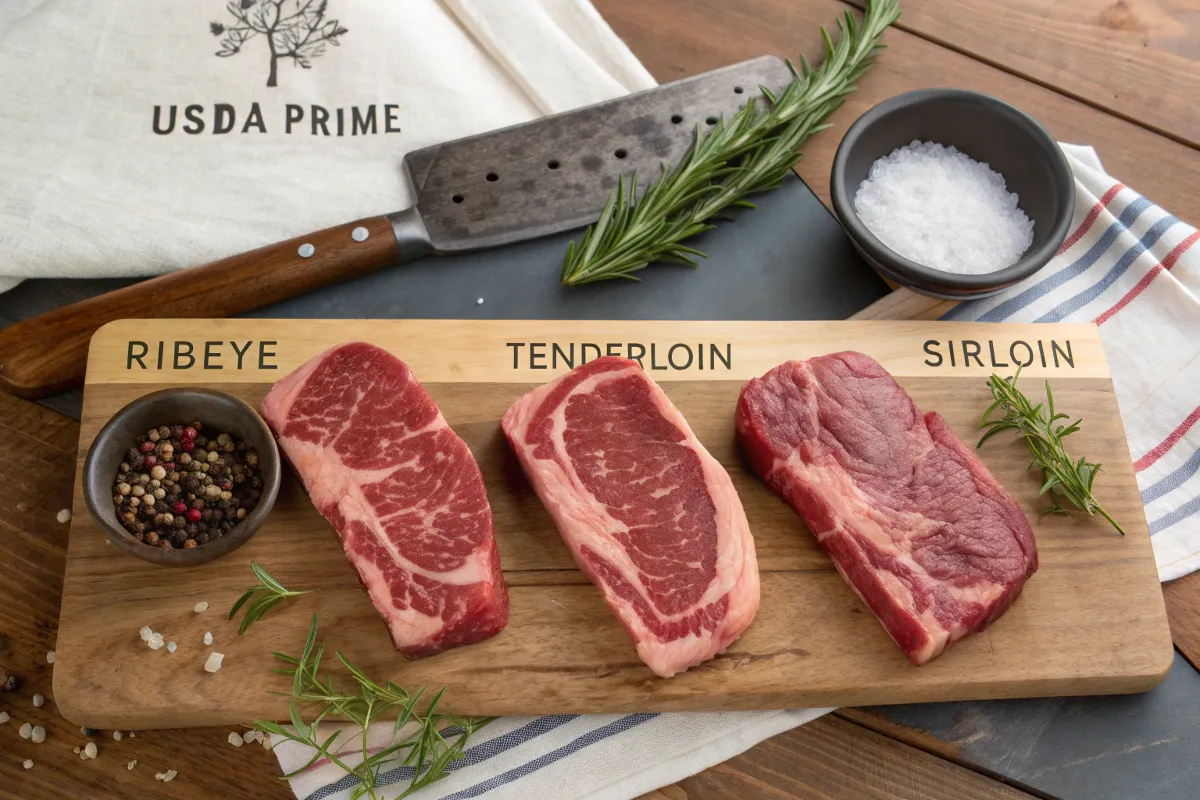
Understanding Different Cuts of Beef
Not all beef is created equal, and your choice of cut can make or break your steak. Some of the most popular cuts include ribeye, tenderloin, and sirloin. Ribeye, known for its rich marbling, delivers an intensely beefy flavor, while tenderloin offers unrivaled tenderness with a milder taste. Sirloin strikes a balance with robust flavor and a leaner profile.
Each cut brings its own charm, so consider your preferences and occasion when selecting. If you’re aiming for a melt-in-your-mouth experience, tenderloin is a no-brainer. Craving a steak that’s juicy with every bite? Ribeye is your best friend.
Selecting the Best Quality Steak
The quality of your steak matters just as much as the cut. Look for vibrant red color, creamy-white fat, and good marbling. USDA Prime is the highest grade, offering excellent marbling, while Choice is a slightly leaner but still delicious option.
Don’t forget sourcing! Grass-fed beef is leaner and has an earthy flavor, while grain-fed beef is richer and more buttery. Supporting local butchers or farms often means fresher, higher-quality meat that outshines supermarket options.
Prepping Your Steak Like a Pro
The Role of Temperature Before Cooking
One of the easiest ways to level up your steak game is by understanding the role of temperature. A steak pulled straight from the fridge will cook unevenly, leaving the center cold and the outside overdone. For the perfect beef steak, always let the meat sit at room temperature for about 30–60 minutes before cooking.
This step ensures even heat distribution, resulting in a juicy and tender bite. Pair this with the perfect cocktail, like one made with crème de menthe, to give your meal a refreshing twist.
Drying and Trimming Your Steak
Moisture is the enemy of a good sear. Always pat your steak dry with a paper towel before cooking to help develop a caramelized crust. If there’s excess fat, trim it carefully, but leave enough for flavor. Fat renders during cooking, creating the rich, buttery notes we all crave in a great steak.
For more kitchen tricks, explore recipes that maximize flavor, such as steak alfredo breakfast recipes.
Tools of the Trade
A chef is only as good as their tools. Invest in a high-quality chef’s knife for precise trimming and a sturdy cutting board. Cast iron pans are also a must-have for achieving restaurant-quality results. Proper tools can be the difference between a good steak and a show-stopping meal.
The Science Behind Seasoning
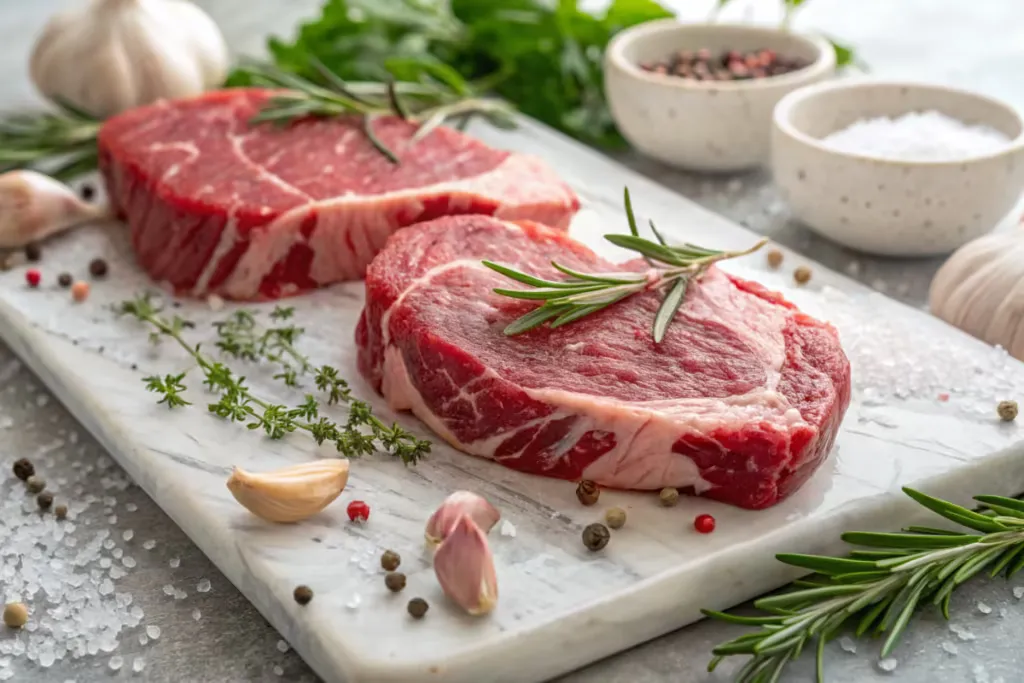
Timing Is Everything
Seasoning a steak isn’t just about sprinkling salt and pepper at the last minute. The timing of seasoning matters greatly. For optimal flavor, salt your steak at least 30 minutes to an hour before cooking. This allows the salt to penetrate the meat, enhancing its natural umami essence.
Salt and Pepper: The Essentials
Keep it simple yet effective. Kosher salt and freshly cracked black pepper are staples for a reason—they elevate the beef without overpowering it. Sprinkle generously, ensuring an even coating on all sides.
Enhance your steak experience with a touch of sophistication by sipping a cocktail featuring crème de menthe—its minty flavor complements the rich, savory taste of beef beautifully.
Exploring Advanced Flavors
While salt and pepper are classics, experimenting with rubs, marinades, and flavored salts can take your steak to new heights. Garlic powder, smoked paprika, and even espresso powder are great additions to your spice arsenal.
For a unique pairing, consider recipes like cheesy garlic chicken wraps that combine bold flavors with creamy textures.
Mastering Cooking Techniques
Pan-Seared Perfection
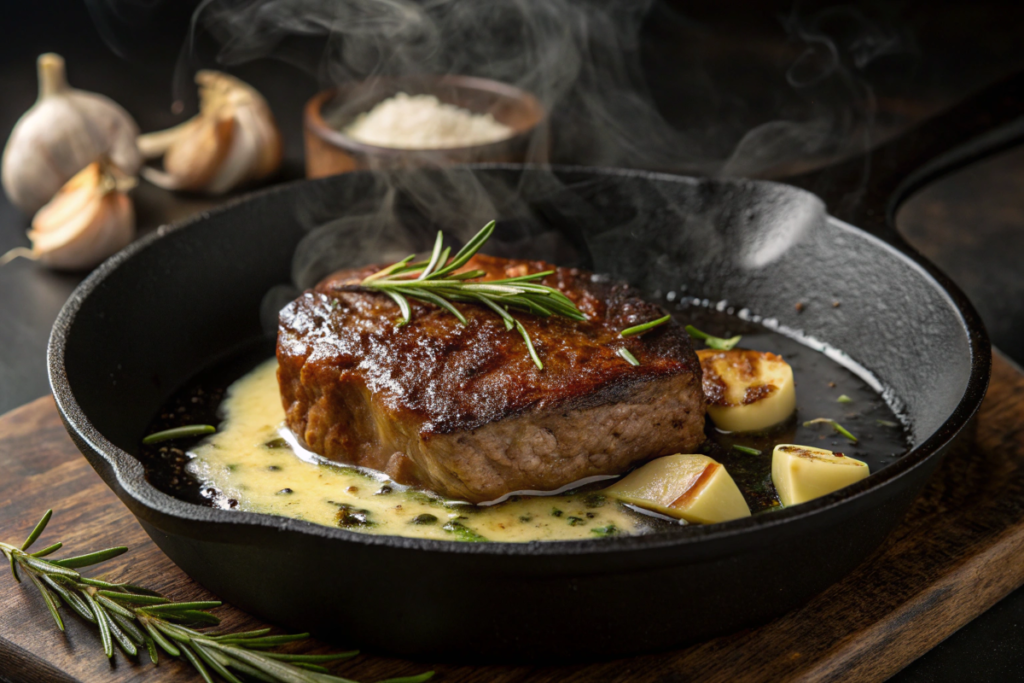
When it comes to cooking a steak, pan-searing is a foolproof method that guarantees a rich crust. Use a cast iron skillet preheated to medium-high heat for the best results. Once the pan is hot, add a high-smoke-point oil, like avocado or canola oil, to prevent burning. Place the steak in the pan and let it sear undisturbed for about 2–3 minutes per side.
The key to perfect beef steak secrets is ensuring a golden-brown crust. To enhance the flavor, baste the steak with melted butter, garlic, and fresh herbs like thyme or rosemary during the final minute of searing. This technique not only adds depth but also keeps the steak moist and aromatic.
For another savory dish idea, explore recipes like meat fondue guide for more ways to enjoy tender, juicy beef.
The Art of Grilling
Grilling your steak offers a smoky flavor that’s hard to beat. Start by preheating your grill to high heat and oiling the grates to prevent sticking. Use direct heat for a quick sear and indirect heat to finish cooking to your desired doneness.
Flip the steak only once to develop beautiful grill marks. For an even better dining experience, pair your grilled steak with a crème de menthe cocktail—it adds a refreshing balance to the rich, smoky flavors.
Oven-Finished Steaks
The reverse sear method is perfect for thicker cuts like ribeye or tenderloin. Begin by cooking the steak in a 275°F oven until it reaches 10–15°F below your target doneness. Then, finish with a quick sear in a hot skillet for a crispy, flavorful crust.
Using a meat thermometer is essential for precision—medium-rare should be around 130°F, while medium hits 140°F.
Using a Meat Thermometer
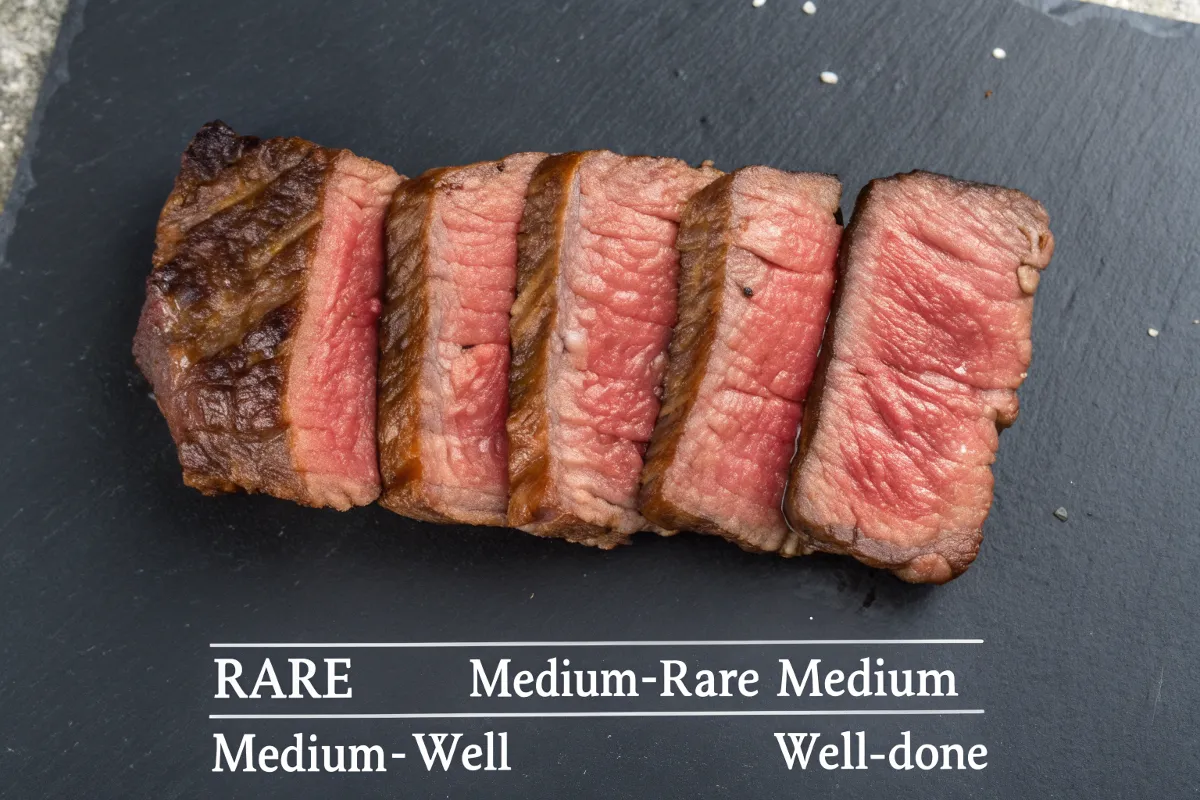
To avoid overcooking, rely on a meat thermometer. Insert it into the thickest part of the steak for an accurate reading. Trusting this tool takes the guesswork out and ensures your steak is cooked to perfection every time.
Serving Your Steak: Presentation Tips
Resting Your Steak
One of the most overlooked steps in steak preparation is resting. After cooking, transfer your steak to a cutting board and let it rest for 5–10 minutes. This crucial step allows the juices to redistribute, ensuring every bite is juicy and flavorful.
While waiting, you can prepare a delightful side, like garlic butter potatoes or roasted vegetables, to round out your meal. For inspiration, check out lemon pepper recipes for seasoning ideas that complement beef perfectly.
Slicing and Plating
To make your steak visually appealing and easier to eat, slice it against the grain. This shortens the muscle fibers, making each bite tender. Arrange the slices neatly on a plate, and consider adding a garnish of fresh herbs or a drizzle of balsamic glaze for added flair.
Pairing Your Steak with the Perfect Beverage
Classic Wine Pairings
A well-cooked steak deserves an equally impressive drink to complement its flavors. Red wines are a timeless choice, with bold options like Cabernet Sauvignon or Malbec pairing wonderfully with the rich marbling of a ribeye. The tannins in these wines balance the steak’s fattiness, enhancing each bite.
For leaner cuts like filet mignon, consider a Pinot Noir or Merlot. These wines have softer profiles that don’t overpower the steak’s subtle flavors.
Creative Cocktails for Steak Night
For a modern twist, pair your steak with a cocktail that elevates its savory notes. A crème de menthe cocktail can offer a refreshing, minty balance to the richness of your steak. Consider crafting a Grasshopper cocktail, blending crème de menthe with cream and chocolate liqueur, for a dessert-inspired pairing that delights the palate.
Elevating Your Steak Dinner with Sides and Sauces
Must-Try Side Dishes
No steak dinner is complete without stellar sides. Classic choices like creamy mashed potatoes, roasted asparagus, and buttery garlic bread are easy crowd-pleasers. For something a bit different, try parmesan truffle fries or a charred Caesar salad.
Want to explore unique recipes? Check out other creative ideas like pickle de gallo salsa for a tangy, flavorful side.
Irresistible Steak Sauces
A good sauce can elevate a steak from great to unforgettable. Béarnaise, peppercorn, and chimichurri are classic choices. For a unique twist, create a simple butter infused with crème de menthe. Its minty aroma adds complexity to the steak while offering a surprising burst of flavor.
For more culinary inspiration, consider exploring recipes on Giddy Recipes to expand your menu and impress your dinner guests.
FAQs
How do I season a steak for maximum flavor?
Seasoning a steak is simple but crucial. Use kosher salt and freshly cracked black pepper for a classic flavor. For maximum impact, season the steak at least 30 minutes before cooking to allow the salt to penetrate. Add other spices like garlic powder or smoked paprika for extra depth.
Is it better to cook steak in butter or oil?
Both have their benefits. Start with a high-smoke-point oil like avocado or canola oil to sear the steak. Finish with butter during the last minute of cooking for added richness and flavor. Basting the steak with the melted butter, infused with garlic and herbs, enhances its savory notes.
What is the best way to check for doneness?
Using a meat thermometer is the most accurate way to check doneness. Insert it into the thickest part of the steak:
- Rare: 120–125°F
- Medium-rare: 130–135°F
- Medium: 140–145°F
Can I use crème de menthe in steak recipes?
Yes! Crème de menthe can be incorporated into a compound butter or glaze for a unique twist. Its refreshing minty flavor pairs surprisingly well with the richness of beef, offering a delightful contrast.
Conclusion
Mastering the art of cooking steak is a rewarding journey that transforms a simple cut of meat into an unforgettable dining experience. From choosing the right cut to seasoning, cooking, and serving, every step plays a vital role in achieving steakhouse-quality results at home.
Pair your perfectly cooked steak with sides and drinks that enhance its flavors, such as a minty crème de menthe cocktail or a rich Béarnaise sauce. With these tips and techniques, you’re well on your way to unlocking your inner steakhouse chef.
So, fire up that skillet or grill, and let your culinary adventure begin. With a little practice, you’ll be serving up steaks that rival any restaurant. Happy cooking!
Print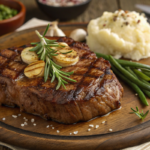
Perfect Pan-Seared Beef Steak
- Total Time: 20 minutes
- Yield: 2 steaks 1x
Description
Master the art of cooking the perfect beef steak with this comprehensive guide. From selecting the right cut to achieving a restaurant-quality sear, this recipe ensures a juicy, flavorful steak every time.
Ingredients
Steak Preparation
- 2 ribeye steaks (about 1 inch thick, room temperature)
- 1 tbsp kosher salt
- 1 tsp freshly ground black pepper
Cooking
- 2 tbsp high-smoke-point oil (such as canola or avocado oil)
- 2 tbsp unsalted butter
- 4 cloves garlic (smashed)
- 2 sprigs fresh thyme
Instructions
- Pat the steaks dry with paper towels to remove excess moisture. Season both sides generously with kosher salt and freshly ground black pepper. Let them sit at room temperature for 30 minutes to ensure even cooking.
- Heat a cast iron skillet over high heat until it’s very hot. Add the high-smoke-point oil and swirl to coat the pan.
- Carefully place the steaks in the skillet, laying them away from you to prevent splatter. Sear without moving for 2-3 minutes until a golden-brown crust forms.
- Flip the steaks and add the butter, smashed garlic, and thyme to the pan. Tilt the pan slightly and use a spoon to baste the steaks with the melted butter for 1-2 minutes.
- Continue cooking until the steaks reach your desired doneness. For medium-rare, aim for an internal temperature of 130°F (54°C). Use a meat thermometer for accuracy.
- Transfer the steaks to a cutting board and let them rest for 5-10 minutes. This allows the juices to redistribute, ensuring a moist and flavorful steak.
- Slice against the grain and serve immediately. Enjoy your perfectly pan-seared beef steak!
Notes
For thicker cuts, consider finishing the steak in a preheated oven at 275°F (135°C) after searing to reach the desired internal temperature. Always rest your steak before slicing to retain juices.
- Prep Time: 10 minutes
- Cook Time: 10 minutes
- Category: Main Course
- Cuisine: American
Nutrition
- Calories: 600
- Sodium: 800
- Fat: 45
- Saturated Fat: 18
- Protein: 48
- Cholesterol: 150

